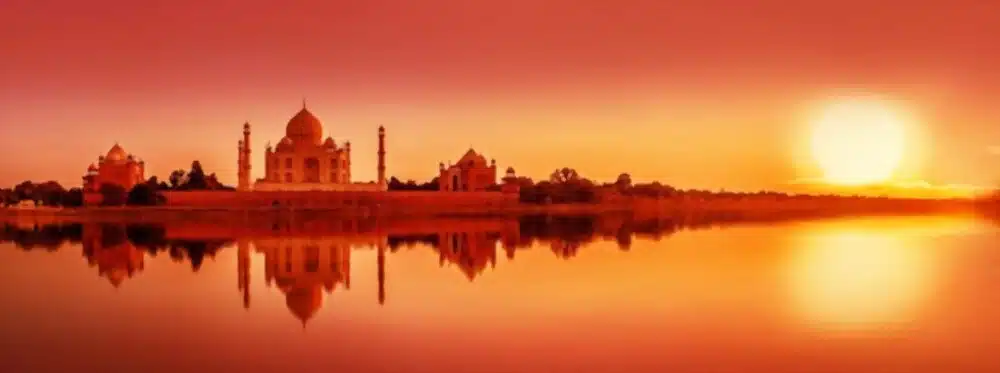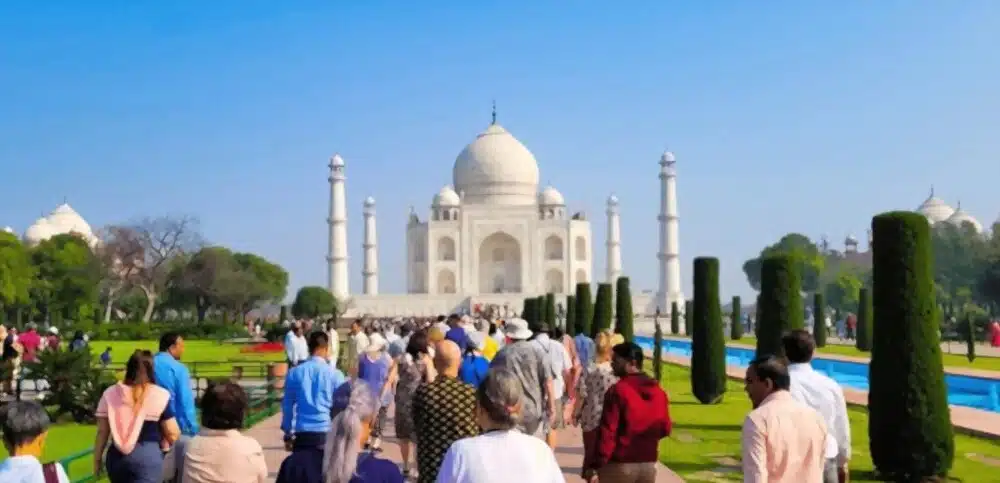
The Taj Mahal is a masterpiece of architectural wonder and an iconic symbol of India’s rich cultural heritage. A visit to this majestic monument is like stepping back in time. Here is a visit to Taj Mahal Essay in English. These are short and long paragraphs in 100, 150, 200, 300 & 400 + Words.
A Visit to Taj Mahal Essay in English- 100 Words
A visit to a historical place is entertaining and instructive. Agra is a famous historical place. It is well known for the Taj. People from all over the world flock to have a glimpse of this dream in marble. I too visited Agra last month to see the Taj. I was overjoyed by the majestic beauty of the Taj right at the outer gate. The serene and silent minarets standing at the four corners appeared to be four sentries guarding the eternal peace of the royal couple. I reached the marble steps and looked up. I saw the big dome of the Taj. Then I went inside and watched the beautiful engravings on the walls. The tombs of Shah Jehan and Mumtaz lay on the ground floor. The beauty of the Taj is beyond description. I felt charmed.
Also Read:
- Essay on Jallianwala Bagh Massacre
- Essay on Beti Bachao Beti Padhao
- Essay on Animals in English
- Essay on Conservation of Plants and Animals
- Essay on My Favourite Book Harry Potter Series
Describe A Visit to A Historical Place – 150 Words
The Taj Mahal, one of the most beautiful and magnificent structures in the world. It is a symbol of true love and devotion. This building is very stunning. It has been constructed with white marble. It is no doubt a masterpiece. The Taj Mahal stands on the banks of the river Yamuna in Agra city. It was constructed by Mughal Emperor Shah Jahan as a tribute to his beloved wife Mumtaz Mahal. It took over 20 years for skilled artisans to complete this breathtaking monument. The intricate carvings, delicate floral patterns, and exquisite calligraphy on its walls are awe-inspiring. The sights of this buildings leave visitors spellbound. The Taj Mahal’s impressive architecture and design have made it one of India’s greatest wonders. It is an icon of artfulness worldwide. Its graceful symmetry has been captured by photographers from around the globe. It is an incredibly popular tourist destination. It attracts millions of visitors each year to gaze upon its beauty firsthand.

My Visit to A Historical Place – The Taj Mahal 200 Words
The Taj Mahal is a timeless symbol of love and beauty. It is a testament to the enduring power of human creativity. It’s a monument that has captivated people from all over the world for centuries.
People are full of awe and wonder with its intricate design and stunning architecture. As you gaze upon this magnificent structure, it’s hard not to be transported back in time. We are compelled to imagine what life was like during its construction.
The sheer scale of the project is astounding. It took more than 20 years to build and involved thousands of workers. But perhaps what makes the Taj Mahal truly special is its unique blend of different styles. This amazing marble building is adorned with intricate carvings that draw on both Persian and Indian influences. They create a synthesis that represents the best of both cultures. And yet despite its grandeur and sophistication, there’s also something profoundly simple about the Taj Mahal.
At heart, it’s just two people expressing their love for each other in stone. An act that speaks to our deepest hopes and aspirations as human beings. So whether you’re visiting India for the first time or returning once again to marvel at this wonder of the world, take some time out to soak up everything that makes the Taj Mahal such an extraordinary place.
For here lies one of humanity’s greatest achievements – a masterpiece that will continue to inspire generations long into the future.
My Visit to A Historical Place Taj Mahal – 300 Words
Taj Mahal is the epitome of love and beauty. It is an architectural masterpiece that leaves visitors spellbound. The white marble structure stands tall on the banks of River Yamuna in Agra. It attracts millions of tourists from across the world each year.
The stunning monument features intricate carvings and designs that showcase a blend of Indian, Persian, and Islamic art styles. The main dome at the center is surrounded by four smaller domes and four towering minarets. The Taj Mahal changes colors throughout the day – it appears pinkish in the morning light, milky white during daytime hours, golden in late afternoon sunsets and silver under moonlight. It’s believed that if you stand with your back against one of its walls facing away from it and whisper something softly towards it; you can hear what someone says even if they are very far away!
In addition to being a tourist attraction today; this UNESCO World Heritage Site remains an important symbol for India’s rich cultural heritage as well as a testament to everlasting love between two human beings.
Visiting a Taj Mahal is an incredibly rewarding experience. Not only you can learn about the past, but it also gives you the opportunity to appreciate how far humanity has come in such a short span of time.
Whether it’s visiting a monument or museum that celebrates the accomplishments of our ancestors or even just taking some time to explore an old ruin, these places are all worth exploring and experiencing firsthand.
Each visit offers something different and provides its own unique insight into our history and culture—making them invaluable for anyone interested in learning more about where we’ve been and where we’re going.

A Visit to Taj Mahal Essay in English 500 + Words
Introduction
The Taj Mahal, one of the most iconic and breathtaking structures in the world, stands as a testament to eternal love. This magnificent mausoleum located in Agra, India is not only a UNESCO World Heritage Site but also considered as one of the Seven Wonders of the World. The Taj Mahal has captured hearts and minds for centuries with its stunning beauty and romantic story.
Let’s explore the history, description, significance and how to visit this wonder of architecture that continues to inspire awe in all who see it. So come along on this journey through time and immerse yourself in the fascinating tale behind the Taj Mahal!
History of the Taj Mahal
The Taj Mahal is one of the most iconic landmarks in India, attracting millions of tourists every year. Its history dates to 1632 when Mughal Emperor Shah Jahan commissioned its construction as a mausoleum for his beloved wife Mumtaz Mahal who died during childbirth.
It took more than 20 years and over 20,000 workers from across India and Central Asia to complete the Taj Mahal. The stunning monument was designed by Ustad Ahmad Lahouri, an Iranian architect who blended Persian and Indian architectural styles to create a unique masterpiece.
The construction of the Taj Mahal costed around 32 million rupees at that time which would be nearly $1 billion in today’s currency! The white marble used for constructing it was brought all the way from Rajasthan while other precious stones were sourced from different parts of Asia.
Despite being regarded as a symbol of love today, the history behind its creation tells a tragic tale. After completing its construction, Shah Jahan was imprisoned by his own son Aurangzeb in Agra Fort where he spent his final days gazing upon the Taj Mahal until he passed away himself.
Today, after centuries have gone by since its inception, the Taj remains an everlasting marvel that has stood against both man-made and natural calamities such as earthquakes and pollution thanks to constant conservation efforts undertaken by government authorities.
Description of the Taj Mahal
The Taj Mahal is a magnificent mausoleum located in Agra, India. It was built by the Mughal Emperor Shah Jahan as a tribute to his beloved wife Mumtaz Mahal who died during childbirth. The structure is made of white marble and features intricate carvings and designs that make it one of the world’s most beautiful buildings.
The main entrance leads visitors to a stunning garden with fountains perfectly aligned on an axis leading straight toward the Taj Mahal. Once you reach the monument, you will be amazed by its sheer size and beauty. The central dome stands tall at 73 meters high and is flanked by four minarets that are each over 40 meters tall.
As you approach closer, you can see how detailed every part of this building is – from its intricate carvings to precious stones used for decoration like jasper and jade. You can also notice how the light plays with different parts of the building throughout different times during your visit, making it even more mesmerizing.
Inside the main chamber lies two tombs – one for Mumtaz Mahal herself, while another for Shah Jahan when he passed away years later. Both lie in perfect symmetry within their respective chambers adorned with delicate motifs all around them.
Experiencing Taj Mahal firsthand offers breathtaking views worth remembering forever!

Significance of the Taj Mahal
The Taj Mahal is one of the most magnificent structures ever built and has a deep significance both historically and culturally. It was commissioned by Mughal Emperor Shah Jahan in memory of his beloved wife Mumtaz Mahal, who died during childbirth.
The construction of the Taj Mahal took over 20 years to complete with thousands of workers involved in its creation. The white marble structure incorporates elements from Islamic, Persian, Turkish and Indian architectural styles which reflects the cultural diversity of the Mughal Empire.
Apart from being a beautiful monument dedicated to love, it also holds immense historical significance as a symbol of peace between conflicting religions – Islam and Hinduism. The gardens surrounding the monument represent Paradise (Jannat) which makes it an important piece in Muslim art.
Furthermore, UNESCO declared it as a World Heritage Site in 1983 due to its remarkable blend of architecture and natural beauty that stands out for centuries since its establishment.
The Taj Mahal’s significance lies not only on being one of the Seven Wonders Of The World but also serving as an inspiration for many poets, artists across generations worldwide because it represents true love between two people that transcends time even after death.
How to Visit the Taj Mahal
Visiting the Taj Mahal is a dream come true for many people. It’s an iconic monument that represents India’s rich history and culture. Here are some tips on how to make your visit to the Taj Mahal unforgettable.
Firstly, plan ahead and book your tickets in advance. The queue can be long, so avoid wasting time by buying your tickets online or at the ticket counter beforehand. Keep in mind that there are different entry fees for foreign visitors compared to Indian nationals.
Secondly, dress appropriately when visiting the Taj Mahal. Respectful clothing is required as it is a religious site of worship; shoulders and knees must always be covered.
Thirdly, arrive early in the morning to watch the sunrise over this incredible building without too many crowds around you obstructing views of its beauty.
Fourthly, hire a tour guide who can provide insight into the history behind this beautiful monument as well as point out interesting details which may otherwise go unnoticed by those unfamiliar with such architecture from past centuries!
Take your time while inside – don’t rush through just because you’re excited! Take plenty of photos but also take moments where you simply stand and marvel at one of mankind’s greatest accomplishments!
10 Amazing Facts about Taj Mahal-
1.Inspiration from the Quran: The Taj Mahal’s architectural design draws inspiration from the Quran. Its four minarets symbolize the four corners of paradise mentioned in the holy book.
2.Changing Colors: The color of the Taj Mahal appears to change throughout the day. It appears pinkish in the morning, milky white in the evening, and golden under moonlight.
3.Calligraphy Mastery: The calligraphy on the Taj Mahal’s exterior walls is not symmetrical. The size of the lettering adjusts to create a consistent appearance to the viewer’s eye, giving an illusion of symmetry.
4.Optical Illusion: The four minarets surrounding the Taj Mahal are slightly tilted outward. This design technique ensures that in the event of an earthquake, they would fall away from the main mausoleum, protecting it from damage.
5.Exquisite Inlay Work: The Taj Mahal features intricate inlay work known as “pietra dura.” Precious and semi-precious stones are meticulously carved and embedded into the white marble, forming stunning floral and geometric patterns.
6.Minaret Leaning: All the minarets of the Taj Mahal are inclined slightly outward. This architectural feature is intentional to prevent them from falling onto the main structure in case of an earthquake.
7.Burial Chambers Below: Beneath the main chamber of the Taj Mahal, there are two identical burial chambers—one for Mumtaz Mahal and the other for Emperor Shah Jahan. However, the actual graves are located at a lower level.
8.Moonlit Garden: The Taj Mahal is surrounded by a charbagh, a Persian-style garden divided into four quadrants by water channels. The garden was designed to reflect the image of the Taj Mahal in the moonlight, creating a serene and picturesque ambiance.
9.Symbolic Number: The Taj Mahal complex comprises several symbolic elements. The number 99, which symbolizes the Islamic concept of paradise, is prominently featured in the design, including the 99 names of Allah intricately inscribed on the main mausoleum.
10.Eternal Love Symbol: The Taj Mahal was built as a testament to Emperor Shah Jahan’s love for his wife, Mumtaz Mahal. It took approximately 22 years and 20,000 artisans to complete this remarkable monument, making it one of the greatest architectural expressions of love in history.
Conclusion
The Taj Mahal is undoubtedly one of the most magnificent buildings in the world. Its history and significance have made it a symbol of love and beauty for centuries. The exquisite marble structure, intricate design, and impressive architecture continue to draw visitors from all over the world.
Visiting this iconic monument is an experience that everyone should have at least once in their lifetime. From witnessing the sunrise or sunset behind its gleaming white façade to admiring its grandeur under a moonlit night sky, there are endless ways to appreciate this wonder of the world.
Whether you are interested in history or simply looking for an awe-inspiring destination for your next trip, be sure to add the Taj Mahal to your bucket list. It truly is a marvel that must be seen with your own eyes to be fully appreciated.
FAQs
1.What are some interesting myths about the Taj Mahal?
Ans: The Taj Mahal is one of the world’s most iconic monuments and it has many myths attached to it. One popular myth is that if someone speaks or sings inside the Taj Mahal, their voice will be magnified tenfold!
Another interesting myth is that the bodies of Shah Jahan and Mumtaz Mahal are buried in a secret chamber beneath the monument.
There are also stories of hidden treasures being buried around the complex. Whatever truth lies behind these fascinating stories, they only add to the beauty and intrigue of this spectacular landmark.
2. Why is the Taj Mahal one of the 7 wonders of the world?
Ans: The Taj Mahal is one of the world’s most iconic monuments and has been listed as one of the Seven Wonders of the World for its stunning architecture and beautiful artistry. This majestic structure was built by Mughal emperor Shah Jahan in memory of his beloved wife Mumtaz Mahal. It is a symbol of love, beauty, craftsmanship, and dedication that stands majestically on the banks of Yamuna river. Its marble domes, minarets, and intricate carvings leave visitors in awe. From its breathtakingly beautiful gardens to its awe-inspiring interior decor, no wonder the Taj Mahal is considered one of the world’s greatest wonders.
3. Is the Taj Mahal worth visiting?
Ans: Absolutely! The Taj Mahal is a stunning sight to behold. It’s one of the most famous monuments in the world, and it has stood for centuries to remind us of love and beauty. Visiting the Taj Mahal is a once in a lifetime experience that will stay with you forever. Its unique architecture, intricate details, and unparalleled landscape make it well worth visiting.
4. What are some facts about the Taj Mahal?
Ans: The Taj Mahal is a mausoleum located in Agra, India. It was commissioned by Mughal Emperor Shah Jahan in 1632 and it took 22 years to be completed. The Taj Mahal is famously known for its intricate marble carvings and its dome shaped structure. The beautiful white marble of the Taj Mahal symbolizes purity and will last for generations to come. It has been declared one of the Seven Wonders of the World and is a popular tourist destination.